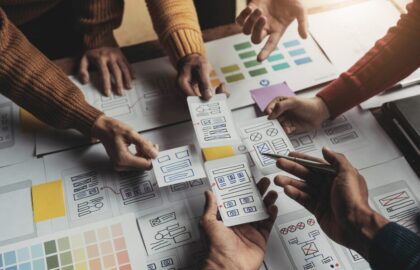If you’re thinking about becoming a UX/UI product designer, it’s time to get familiar with the design thinking approach. This concept is central to creating innovative, user-centric products and services, like websites, apps, or even coffee makers.
Design thinking isn’t limited to UX/UI design — it’s used across all industries and is taught at leading universities around the world. To that end, global brands such as Samsung and Google have embraced the approach. If you’re ready to level up as a UX/UI Designer, this is a skill you need to know.
Driving Innovation with design thinking?
So, what is design thinking in UX/UI design? Why is it so popular? And how does it drive innovation? We’ll explore the meaning of design thinking, the five-stage process for coming up with effective products and services, and where you can get started with design thinking for UX/UI design.
What’s covered?
- What is design thinking?
- What are the 5 stages of the design thinking process?
- Empathy – understand the user’s needs
- Define – state the user’s needs and problems
- Ideation – come up with innovative ideas
- Prototype – start coming up with solutions
- Test out solutions
- Where can I learn design thinking for UX/UI design?
- What Design Thinking courses are available?
What is design thinking?
Design thinking is a human-centric design methodology first mentioned in 1969 by cognitive scientist and Nobel Prize laureate Herbert A. Simon. But, the idea didn’t stop there. Design thinking has only continued to develop with the exponential growth of the tech industry.
Design thinking is now considered a key concept in user-centered design. That being said, an understanding of the approach is fundamental for people looking to get started as UX/UI Designers.
To expand, design thinking is an approach to problem-solving that focuses on innovation and creation. UX/UI Designers use the design thinking process to discover problems and come up with creative solutions by thoroughly understanding their users’ goals, frustrations, and end-task.
Goals of design thinking
Their goal is to design products that are easy to use, rather than expecting users to adapt to said products.
As the world becomes increasingly complex, many organizations have successfully implemented design thinking to find solutions for little-known problems. (That is, problems we didn’t even know we had!)

Take Amazon or Airbnb, for example. Amazon, in particular, has revolutionized the way we shop. The platform is easy to use and adds value by making shopping fast and fun. Design teams for companies such as these identify and reframe everyday “problems” in ways that focus on what is ultimately important for users.
For example, let’s consider the everyday vegetable peeler. What was once a metal peeler with a metal handle, Sam Farber’s wife spoke up that the peeler was quite uncomfortable on her arthritic hands. Sam set out to make a more comfortable peeler. But first he needed to focus on the user’s needs to understand what was hurting and how.
Sam made many revisions such as a wider handle and a softer material (rubber) that would also provide a more stable grip. All of the revisions he made were an improvement for his wife who had arthritis, but also proved helpful for people without arthritis.
Why? Because the product was easier and more comfortable to use overall.
This is design thinking in action.
Design thinking in UX/UI design
Especially important in user experience (UX) design, design thinking helps to address changes in users’ environments and behaviors that may not be immediately apparent. This is good news for both users and the company bottom line, as designers are continuously researching, testing, and improving products.
UX designers put themselves in the user’s shoes, becoming empathetic to their desires and grievances. They also follow a set of hands-on steps (often used interchangeably with phases and stages). Ultimately, using design thinking allows UX teams to do better research, prototyping, and usability testing to address human needs in the modern age.

The five phases of design thinking:
- Empathize
- Define
- Ideation
- Prototype
- Test
However, design thinking is a non-linear process. This means that designers can re-visit each phase in an iterative way. That is, they continuously re-examine the product and processes to understand users, challenge assumptions, redefine problems, and create innovative solutions. Since product design teams are prolific in their approach, creativity and problem-solving are valuable skills for both UX and UI designers.
The importance of feedback in design thinking

Feedback is also critical in the design process. According to Oxford Languages, feedback is, “information about reactions to a product, a person’s performance of a task, etc. which is used as a basis for improvement.”
Design teams utilize user feedback to come up with improved versions of their ideas or products. However, the feedback isn’t static. Rather, it’s cyclical. Therefore, design teams may establish feedback loops in order to maximize user feedback.
In feedback loops, design teams quickly build, measure, and learn from users in an cyclical fashion. They continuously tweak their products and ideas until the best possible outcome is reached.

In order to obtain feedback during usability testing, teams may:
- Administer anonymous surveys
- Observe user’s during testing
- Ask open ended questions during interviews
- Announce ideas in a public forum and monitor response
There is also room for experimentation in the design process. Design Thinking for Public Policy Innovators puts it this way, “By embracing experimentation we push ourselves to stay experimental, to build to think, to engage people with artifacts, and to elicit and receive feedback in a way that will help us learn more about both our designs and about design thinking.”

Throughout the feedback process, it’s essential to focus on the average user rather than the extreme of either end of the spectrum. It’s simply not necessary to spend time and energy on perceived issues that may only affect the user’s perspective incrementally. Instead, it’s more productive to focus only on collecting and using feedback that will change the core user experience to a greater degree.

The five stages of the design thinking process
Design thinking is a five-stage process as defined by the Hasso-Plattner-Institute of Design and based on the original method developed at Stanford (also known as d.school). The stages are flexible and do not always need to be followed in order. Teams may run them in parallel or out of order and re-visit stages as needed in the iterative process.

Stage 1: Empathy — understand the needs of people
The first stage of the design thinking process is to gain an empathic understanding of the problem you are trying to solve. Understanding the human point of view is crucial.
This is when designers go into detective mode to get to know the user and understand their desires, needs, and objectives when interacting with a product or service.
This detective-designer will come to understand the “problem space,” or what is currently hindering the completion of the task. This looks like conducting user research by observing people and/or asking questions.
During this phase, designers set aside their own beliefs and assumptions.
Instead, they get into the mind of the user on an emotional and psychological level to come up with actionable insights. And then use insights from stage one to inform the remaining stages.

Stage 2: Define — state the user’s needs and problems
Next, the designer must clearly define the user’s needs and problems. They begin by making sense of the data and observations gathered during stage one, for example:
- What patterns do they see?
- What did they hear most often?
- What difficulties did the users have?

This is also the stage in which designers create user personas to remind them to keep the discussion on the end-user. Once the team has identified core issues with the product or service, they formulate a problem statement. The problem statement should remain user-centric. For example, “Millenials in NYC will…” rather than, “Our team will….”
Once designers have put the problem into words, they start to come up with solutions and ideas. It’s now time for stage three.
Stage 3: Ideation phase — come up with innovative ideas

Here comes the fun part! Design teams get to be wildly creative when problem-solving in the third stage — ideation. With an understanding of the end-user and a clear problem statement, designers hold collaborative ideation sessions and use ideation techniques. Brainstorm, Worst Possible Idea, and SCAMPER are all ideation techniques that designers use to come up with possible solutions.
The goal of an ideation session is to look at the problem from all angles and generate as many ideas as possible.
For example, the “Worst Possible Idea” ideation technique works as a great icebreaker, putting teams at ease as they come up with the worst ideas and then seek alternatives.
Brainstorming leverages the collective thinking of the team, generating many more ideas than an individual writing his or her own list.

Lastly, teams can take an existing product, service, or idea and go through the SCAMPER list (Substitute, Combine, Adapt, Modify, Put to another use, Eliminate, Reverse) in order to improve it. To start practicing this skill, begin Freewriting regularly — setting a timer and letting your ideas flow uninterrupted and without judgement — and then going back to pull out the best ideas.
At the end of the ideation stage, the best ideas will move forward to the next phase, prototyping.
Stage 4: Prototype — start creating solutions

The next step in the design thinking process is prototyping. It’s about taking all the ideas from stage three and creating tangible products to experiment with. With the concept fleshed out, UX designers are now able to produce several inexpensive, scaled-down versions of the product or specific features found within the product.
This is important because it allows designers to test and validate their ideas quickly and cheaply. It also may bring forth additional iterations of the product’s initial concept before final execution, avoiding costly mistakes.
Prototypes can take many forms — low-tech sketches, storyboards, and rough paper prototypes to mocked up, coded apps on the high end.
With the high or low-fidelity prototypes, it’s time to investigate and run experiments to see if the solutions generated in the previous stages function. Although a designer may personally like one prototype the best, this phase aims to identify the best possible solution for each of the problem statements, always keeping the end-user in mind. It’s essential that teams work together to test and highlight any flaws, and accept, improve, or reject the ideas based on data.
Once you’ve agreed on the best prototype, you are ready to test your product in the last stage.
Stage 5: Test — try out solutions

In the last stage, evaluators rigorously test the complete product. Although this is the last stage in the design thinking process, it’s not likely the end. The results either confirm or challenge the solutions from a previous stage. Since design thinking is iterative, designers examine the results and head back to previous steps, constantly making changes, refining, and improving.
Remember, these hands-on steps are not necessarily sequential, and teams may revisit them as needed. The main goal throughout is to gain a deeper understanding of the users and what their ideal product would look like.
Where can I learn design thinking for UX/UI design?
Let us not forget that behind every good product, there’s a business to be run. It’s obvious that design thinking is a factor in running a successful business, especially in the age of technology.
If you want to become a UX/UI Designer or a digital product designer, you will definitely need to be familiar with the design thinking process. Luckily, you can get started online. Start by checking out these resources:
Media & web:
- Check out Tim Brown’s blog’s Design Thinking Pioneer for recent developments in the field.
- For a compelling look at the approach, watch this documentary.
- Study other examples of design thinking projects.
Books:

- The Design of Everyday Things (Don Norman, Revised 2013) – In this influential book, the author provides examples of flawed designs such as the now-famous “Norman door,” a must-know notion for any product designer.
- Interaction Design (Sharp, Preece & Rogers, 5th Edition) – Students and professionals will benefit from this resource for learning the interdisciplinary skills needed for interaction design, human-computer interaction, information design, and web design.
-
The Design Thinking Playbook: Mindful Digital Transformation of Teams, Products, Services, Businesses and Ecosystems (Lewrick, Link & Leifer, 2018) – This book describes how design thinking is applied across a variety of industries and is full of actionable information for digital transformation.
What design thinking courses are available?
- IBM has free tools and courses to help designers bring a focused approach to their businesses.
- IDEO U has short courses to dip your toe into design thinking.
- Ready to go all in? The Product Design course at Flatiron School covers UX and UI design in depth, and encompasses design thinking. It teaches you everything you need to know to become a product designer.
In this article, you’ve learned what design thinking is and how to implement it in five stages. You have also come to understand that it’s all about the user. Lastly, you understand how it’s implemented in product design to construct best possible solutions to everyday products and services, both digital and physical.
If you’re ready to put these ideas into action and become a product or UX/UI Designer, consider taking an online bootcamp!
Flatiron’s Product Design Course
To learn how to engage in design thinking at Flatiron School, check out our Product Design program.




